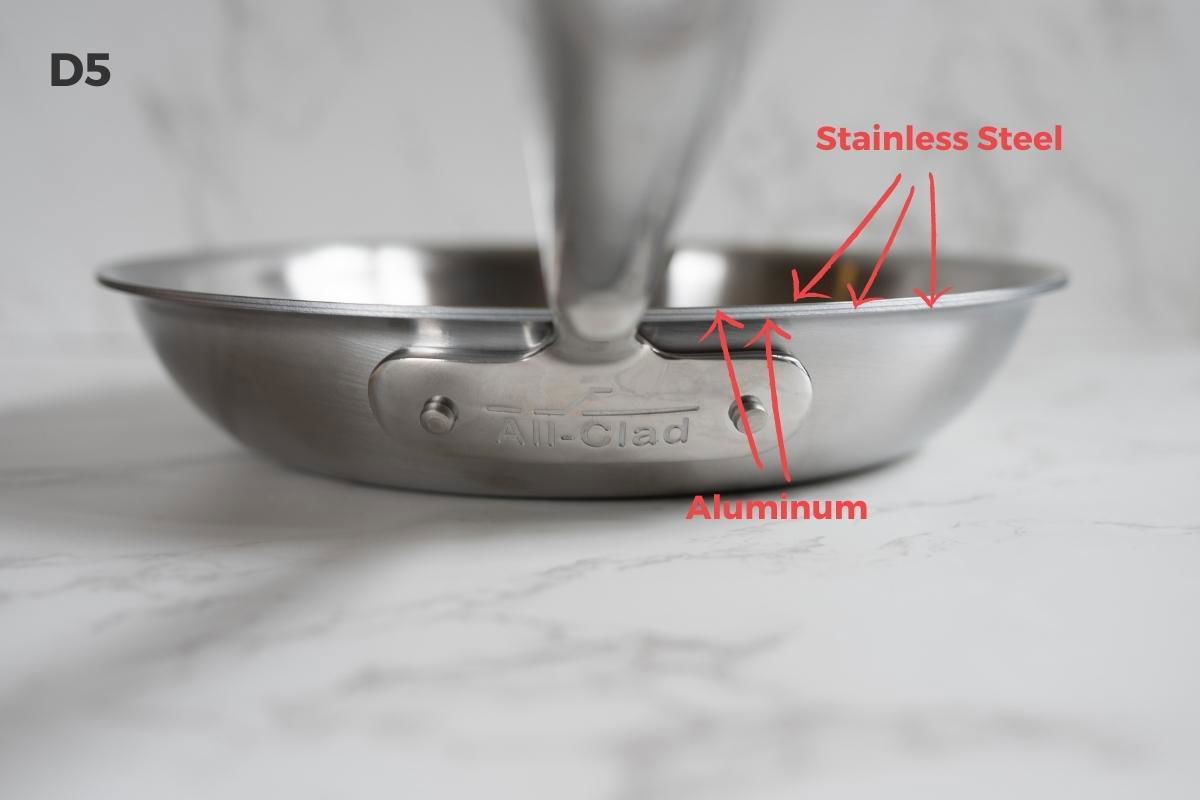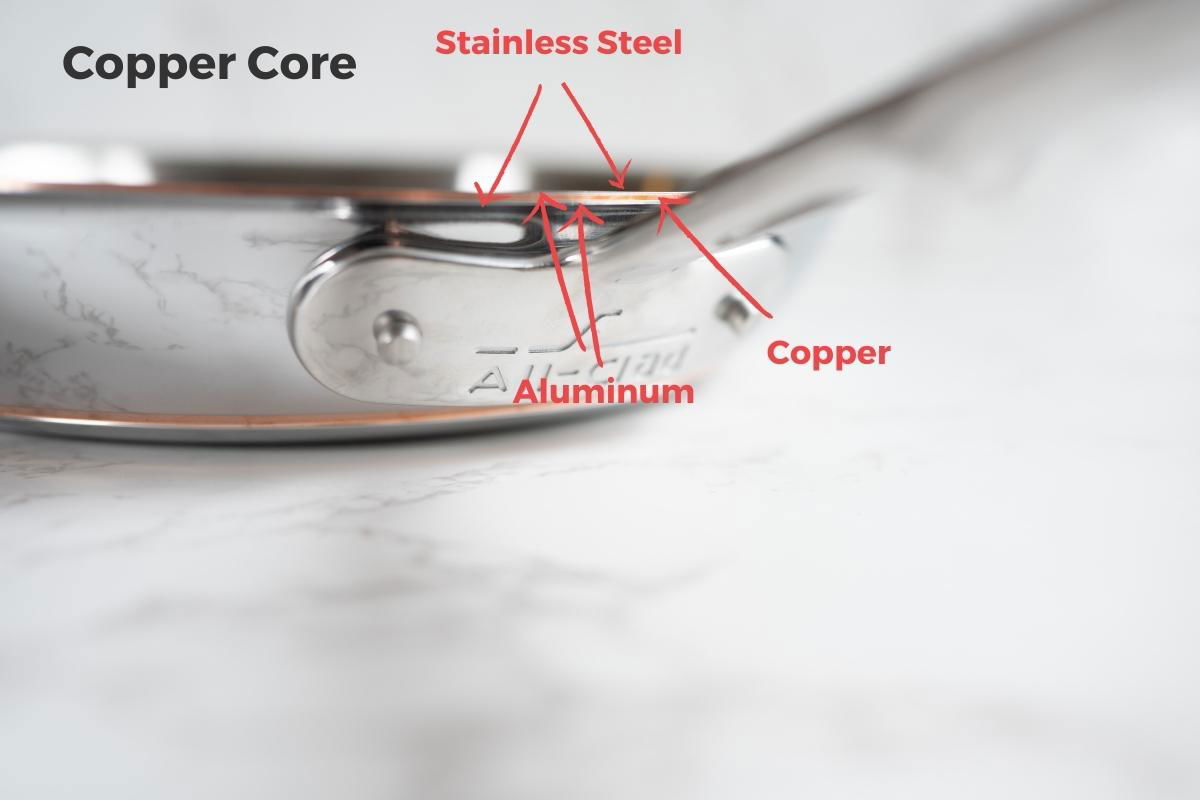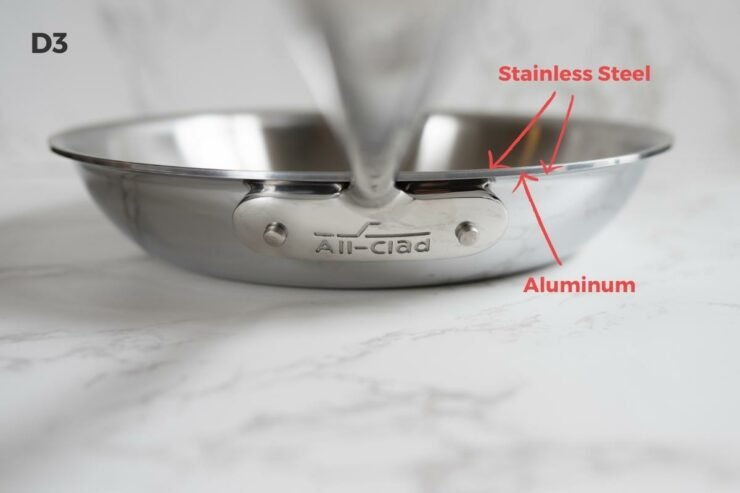All-Clad has been among the best American-made cookware brands for over half a century. But over most of that period, they only sold one cookware collection.
The company invented the roll-bonding process known as “cladding,” their signature pan construction for decades. Copycats flooded the market when their original patents expired about twenty years ago. All-Clad introduced several new lines (covered by new patents) to stay ahead of the competition.
In this article, I’ll walk you through the major differences from one collection to the next. We brought each of them into our Test Kitchen for a side-by-side comparison. You might be surprised to learn which one worked the best.
In This Article
A quick comparison of All-Clad cookware sets
| Collection | D3 | D5 | Copper Core | HA1 | Essentials | Fusiontec |
|---|---|---|---|---|---|---|
| Layers | 3-Ply | 5-Ply | 5-Ply | Single | Single | Single |
| Core Materials | Aluminum | Aluminum, Steel | Aluminum, Copper | Hard Anodized Aluminum | Hard Anodized Aluminum | Stainless Steel |
| Exterior Finish | Polished | Brushed, Polished | Polished | Brushed | Brushed | Ceramic |
| Oven-Safe Rating (F) | 600 | 600 | 600 | 500 | 500 | 500 |
| Handles | Stainless Steel | Stainless Steel | Stainless Steel | Stainless Steel | Stainless Steel | Stainless Steel |
| Lids | Stainless Steel | Stainless Steel | Stainless Steel | Glass | Glass | Stainless Steel |
| Manufactured In | USA | USA | USA | China | China | Germany |
| Cost | $$ | $$$ | $$$$ | $$ | $$ | $$ |
Choosing the right All-Clad collection
When checking out All-Clad, I recommend always looking at clad steel collections first.
Not only is this what the brand is best known for, but the original All-Clad design is probably the most widely copied cookware construction in the world. Most of the other top stainless steel cookware brands offer nearly identical copies.
Because each collection features many pieces, I’ve focused this comparison on the most universal dish – the frying pan.
D3
All-Clad’s D3 line follows the brand’s original clad 3-ply pan design.
Each of the 50 individual pans in the collection is constructed using a food-grade 18/10 stainless steel cook surface, magnetic stainless steel exterior, and an aluminum core.

These materials are bonded (or “clad”) together in sheets. This method enables a single piece of cookware to take on the material advantages of each of the individual components,
- Stainless steel is durable, non-reactive with acidic foods, and provides even heat retention. It also isn’t susceptible to corrosion and rusting.
- Aluminum conducts heat quickly, which means that these pans heat up quickly.
Although the cost is slightly more, the quality of manufacturing is incredibly high compared with most other brands that are making similar products. We rated the D3 line’s 10-inch skillet as our most recommended frying pan.
Second-rate production items are set aside, including those with minor cosmetic defects.
All-Clad and many owners of this line might tell you that the D3 line is dishwasher friendly, but we’d recommend hand-washing only. I’ve tried cleaning in the dishwasher and can say from personal experience that hand washing is both easier and more effective. Beyond my anecdotal recommendation, the brand recently settled a class action lawsuit disputing all stainless steel lines’ dishwasher compatibility.
Like all of All-Clad’s stainless steel cookware, this line is rated oven-safe to 600 F.
D5
After testing them side-by-side, we concluded that the primary difference between the All-Clad D3 and D5 collections is the number of layers of metal used to construct the cookware.
Unlike the D3 collection, All-Clad D5 has five metal layers – two layers of stainless steel sandwiching two layers of aluminum with a magnetic stainless steel layer on the exterior.

The additional layer of aluminum improves heat distribution and minimizes the possibility of hot spots. As a result of the extra layers of metal, the D5 collection is heavier than the D3 collection and is also more expensive.
Although the D5 collection offers incrementally better performance, especially for searing thick pieces of meat, we found that (for most people) the benefits don’t justify the jump in price.
And after speaking with several professional chefs, we found that D3 was the staple cookware even in restaurant kitchens. Not D5.
There is one purely-aesthetic advantage to the D5 collection. Unlike the D3, you can get it with a brushed exterior finish.
The aesthetic is one area where D5 offers more flexibility than D3. This line is available in a brushed finish which looks nice, although the mirror polished option will also patina with time.
The long handles on the D5 collection are ever-so-slightly narrower than D3 and offer a gripper dimple near the base of the handle. In fact, the dimple is so close to the pan that you’d only want to grip it when it is cool.
Copper Core
Copper Core is All-Clad’s top-end line. And it looks incredible when the light strikes it just right!
But how does it perform?
We tested the Copper Core frying pan in our Test Kitchen and were pleased with the results. But not blown away.

Copper is significantly more conductive than aluminum, so you might expect the Copper Core collection to heat much faster than the D3 or D5 line. In our trials, the advantage was underwhelming.
Copper is also significantly more expensive than aluminum; if cost is an object, you will feel the difference. Copper core products tend to be priced 50% above D5 and 100% above D3 comparables.
Like all of All-Clad’s stainless steel lines, the construction is incredibly high quality for this line. But if you buy Copper Core, don’t buy it for the performance benefits.
Yes, it performs slightly better than the other lines, but the truth is that most home cooks won’t notice a difference. And it’s ~15% heavier than D5.
Buy this set because it looks great! And not many others can afford it. The attention to detail in the design of the handle and the exposed copper at the rim and base is exceptional. Pick this set for how it makes you feel.
HA1
All-Clad’s HA1 collection is an excellent choice for those who want the convenience of non-stick cookware without sacrificing quality or performance.
Nonstick cookware products are a bit “off-brand” for All-Clad, but this one checks out and is actually one of our favorite nonstick collections this year. It offers better durability and heat retention than most nonstick pans because of the materials used in construction.
HA1 is built on a thick hard anodized aluminum base and a stainless steel disc clad to the bottom of the pan. The magnetic disc technically makes this set induction-compatible. Still, we found in live testing that it doesn’t work as well on an induction stove as other materials.
Compared with All-Clad’s classic stainless steel collections, the HA1 is exceptionally convenient because of the PTFE-based nonstick coating. Especially for a beginner, you can avoid A LOT of messes by choosing nonstick over stainless steel.
Another benefit of HA1 is its affordability. Because the pan is made from inexpensive materials and not produced in the USA (made in China), you will find it at a lower sticker price.
That said, there is a real problem with nonstick pans not lasting even with the HA1 set. If you have the time and patience, you’re better off learning to cook on stainless steel. They look better, work better, last longer, and can do more.
Our HA1 daily frying pan lasted 6 years. That is a lot for a nonstick pan, but certainly not a lifetime.
Why Is All-Clad So Expensive?
The high cost of All-Clad is due to several factors, including the high-quality materials used in its construction, the cost of labor in the United States, a precision manufacturing process, and the brand’s reputation.
All-Clad uses only the highest quality materials, such as stainless steel, copper, and aluminum, which are generally expensive. The multi-ply construction process combines these materials to create durable and efficient cookware.
The manufacturing process for All-Clad cookware is also highly precise, ensuring that each piece is crafted to exacting standards. This attention to detail requires specialized machinery and skilled workers, which adds to the cost of the product. Work on the stainless steel lines is done in the US, which isn’t exactly cheap.
While there are several differences between All-Clad and copycat brands (like Calphalon), the most notable one is the level of quality control applied to their products.
All-Clad has built a reputation as a premium brand synonymous with quality and performance. This reputation allows All-Clad to charge a premium price for its cookware, as customers are willing to pay for the assurance that they are getting the best.
A great way to find All-Clad at an affordable price is to wait for their Factory Seconds sale, which happens a few times each year. During this online flash sale, the brand offers up products that didn’t pass their quality inspection process – in most cases due to a scratch or cosmetic defect.
The quality of products offered in the sale is a testament to the brand’s high standards for production. If you get an All-Clad product, our experience says it will be worth the investment.
Is All-Clad made in the United States?
While most iconic American cookware brands have moved production overseas in recent years, All-Clad kept production of their fully-clad cookware in the USA.
All-Clad’s D3, D5, and Copper Core lines are still produced in Pennsylvania. However, the handles and lids are now made overseas and assembled in the US.
Since being acquired by French cookware titan Groupe SEB in the early 2000s, the All-Clad brand has also released a few disc-clad and nonstick cookware lines produced in China. But the core product offering is still made in the USA.
What is the best All-Clad collection?
The All-Clad D3 collection is our top recommendation among stainless steel cookware brands. You get most of the performance benefits and top-level craftsmanship you would expect with any All-Clad line. And the value-for-cost is spot on.
The D3 is exceptionally durable, has quick heating, and delivers an even sear. It’s also much lighter than the D5 of the Copper Core collection. All of the clad collections carry similar dishes and a fairly consistent aesthetic.
With that said, if cost isn’t a factor for you, then the Copper Core Collection has more of a premium look to it. The upgraded design details are subtle but quite elegant. The copper rims and improved handle say a lot without being gaudy or in your face.
FAQ
Do chefs use All-Clad?
Yes, All-Clad is a mainstay in restaurant kitchens because of the brand’s reputation for quality control and durability. These pans will take a lot of abuse, which is essential in a high-volume high-stress commercial environment.
Why does everything stick to my All-Clad pans?
All-Clad’s stainless steel cookware collections are not non-stick, so you must add cooking fats or oil to prevent them from sticking. Preheat your pan and confirm it is hot using the water drop technique before adding cooking fat. Use dry ingredients and allow them to sear sufficiently before moving them around.
What should you not do with All-Clad?
Avoid harsh detergents or abrasive cleaners when removing stains and stuck food from your All-Clad stainless steel pan. Learning to clean stainless steel cookware isn’t difficult but may require some practice. Never rapidly cool an All-Clad pan under cold water. It may warp.






